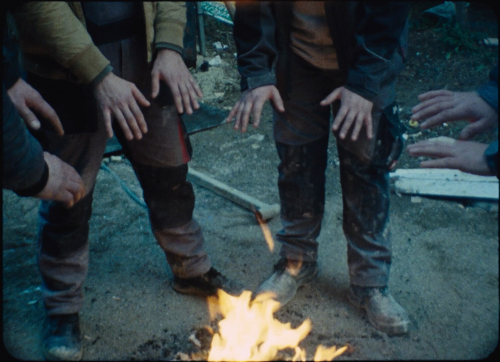07/08/2024
In the darkness of the night, a hand tries to find something among the long blades of grass, where an electric light illuminates a photograph. Indirectly, a man's voice begins to talk about dreams:
”It’s as if you were to cut the wings of a dove, or any bird; it thinks of flying, but when you break its wings, it cannot go anywhere.”
The poetic analogy above reminded me of my grandfather, who, when talking about his work challenges as an emigrant in Germany, always used similar metaphors and comparisons. The description of the desires of a wingless bird accurately captures the deep problems of the working class in Kosovo, which in recent years have garnered attention in the field of visual art.
The testimonies of three laborers—Milazim, Fatmir, and Liridon—are the subjects followed in the film Workers Wings by Ilir Hasanaj. The director’s exploration of their daily problems is the result of thorough research and a close connection he has developed with the characters, allowing for an honest and dignified portrayal of the worker figure. The investigation of the theme revolves around an observant and careful impulse regarding the working conditions and serious physical injuries of the workers, which have led to the loss of limbs. By focusing closely on the workers' physical exhaustion, clearly visible on their faces, we delve into the tormented picture through which the constant danger characterizing the harsh reality of the worker in Kosovo unfolds.
Shot on 16mm film, Hasanaj has harmonized the colors of the film with the fatal reality of working conditions in Kosovo. The overlay of reddish hues on the characters’ faces creates an added aesthetic that outlines the murky circumstances of work danger. The story unfolds slowly and without impositions. It often seems as if we are facing them and conversing with them. As they talk about insecurities and job loss, the workers also touch on the unjust relationship with the current system. This continuous powerlessness has a calm and leisurely tempo. Through the way the film is edited, Milazim, Fatmir, and Liridon are given time to reveal their experiences of physical injuries, without being disturbed by the heavy burden of pain.
The inclusion of claustrophobic landscapes where work machines, wagons, cranes of tall buildings, and drilling tools are visible emphasizes the constant fear and terror awaiting the workers out there. The camera often captures the workshops and the moving wheel systems, a testament to the fact that danger can be triggered at any moment. Moreover, in a building under construction—a familiar sight to anyone living in Kosovo—a worker is seen slipping. Nearby, in these work systems, the worker appears small and unprotected.
The film ends with the work tools that continue to threaten the lives of workers in Kosovo. Inside an elevator, a melody is heard. Along with it, we leave behind the stories that conclude with an X-ray of a spinal column, which looks similar to that of my grandfather, and which we still keep in the drawer.
Review by Blerta Haziraj
Translated by Plator Gashi
DOKUKINO PLATO
Time & Date
20:00 / Wed 7 Aug, 2024
KINO ABI ÇARSHIA
Time & Date
15:30 / Sat 10 Aug, 2024



